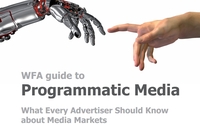Commentary
Deathwatch: Agency Edition
- by Brian Wieser , September 12, 2014
 Certain themes continually return to certain sectors, especially if the short-term newsflow seemingly supports the trajectory of those themes. Last week we
revisited the flawed “death of TV” notion; this week we return to the equally overdone issue of agency disintermediation.
Certain themes continually return to certain sectors, especially if the short-term newsflow seemingly supports the trajectory of those themes. Last week we
revisited the flawed “death of TV” notion; this week we return to the equally overdone issue of agency disintermediation.
The most prominent recent news in this area was associated with a report from the World Federation of Advertisers, which highlighted concerns many marketers have with agencies’ programmatic media trading practices. In news that was probably less followed in most of the world, but which reflected investors’ fears in this sphere, the Australian airline Qantas indicated it would bring its digital media spending – including programmatic buying – in-house from Publicis’ Zenith Optimedia.
As we have indicated in the past, we believe some marketers will find that bringing programmatic media buying in-house can produce benefits, although just because marketers can do so doesn’t mean that they will. Issues include attracting and retaining talent (especially with skills which differ meaningfully from conventional in-house marketing teams), sustaining necessary capital expenditure budgets and maintaining enough of a flow of activity to learn what are increasingly sophisticated best practices. Further, they will lack the per unit price advantage driven by the scale based buying that agencies who build private marketplaces will have. Optimal integration with planning and buying other media is another challenge too.
Still, these drawbacks may not overcome the advantages that many marketers see, including the opportunities that come from applying sensitive data to media in order to make buying more efficient, even if per unit prices are higher (made possible if fewer units are required to accomplish specific buying goals). As well, marketers receive the comfort (or at least hope) that the prices they pay for media and technology will be sufficiently transparent to meet the requirements their procurement teams set out.
Marketers regularly consider bringing work in-house, and many do just that without meaningful ill-effect on the agency industry. In 2008, the US advertiser trade body, the ANA, released a study indicating that 42% of marketers in its survey had established in-house agencies. By last year the figure was 58%. And yet over that same time period, agency revenues and margins expanded, well beyond the pace of growth for the broader economy and media industry; media agencies grew even faster. This is largely because even if marketers bring more and more work in-house (which may indeed be the case) agencies are continuously able to find new services to sell through to most of their clients, especially the most valuable large ones. Many of them (if not most) likely value integration within certain silos, like media separate from creative, and perhaps both separate from below-the-line work. They also evidently value the newer services agencies offer which are made possible because of the fragmentation of media, and which probably contribute significantly to margins.
We think that most marketers who try to bring more work in-house will discover it’s not for them; some will find it works out. And the holding companies will probably benefit from some of these marketers eventually returning to working with the holding companies. Take AB Inbev’s Anheuser Busch, for example. AB pulled its US media planning and buying out of agencies overall several years prior to 1992. While it took a while, in recent weeks news emerged that AB is very close to returning this business back to an outside agency through a review.
The act of bringing and sustaining digital media buying in-house is certainly different than doing the same for TV, and perhaps more marketers will attempt to do (and sustainably succeed at doing) with digital what they were unable to do with TV. While this represents one end of a continuum and simply assigning a budget to an agency to buy digital inventory is at another end, there are a range of potential arrangements that can be made between marketers and agencies to buy programmatic inventory. For example, a marketer may determine for itself which ad tech companies it wants its agency to work with, and how the parties work together (with respect to managing invoices or owning data, for example). Another would involve the marketer and agency jointly selecting ad tech partners with best efforts applied towards pricing transparency, including appropriate audits. Many points regarding the different approaches marketers and agencies can take to make trading desks work better for marketers were even conveyed in the WFA report.
In the grand scheme of things, threats of agency-marketer disintermediation shouldn’t be of much concern. Agencies are always mindful of finding ways to retain business in one form or another. Larger marketers always look to find ways to reduce fees for like-for-like efforts, and are usually successful. Perhaps the fees paid for programmatic trading will effectively follow the same course. But other new products and services will emerge as they necessarily will in what remains a continuously evolving and fragmenting industry. Those products will probably start out as high margin and find themselves eroded, only to be replaced by yet more that follow. Agencies don’t die easily; they usually just evolve, and usually for the better.



Or, as Rishad Tobaccowala said: "Agency are like cockroaches, we are very difficult to kill and very resilient."